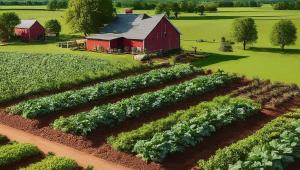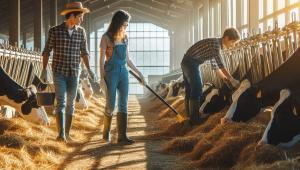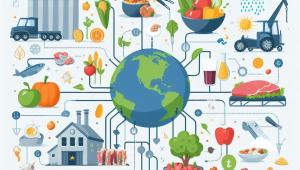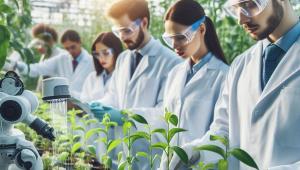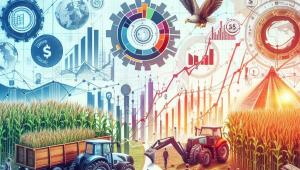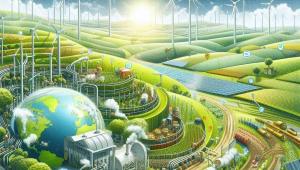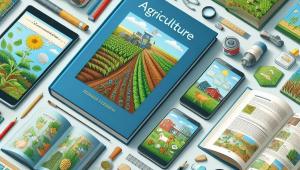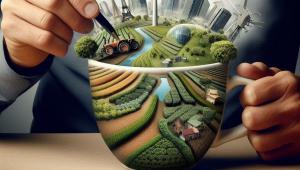A few threads are as vital and enduring as agriculture In human civilization. From the first seeds sown in ancient Mesopotamia to the high-tech farms of today, agriculture has been the cornerstone of societal development. But as we venture deeper into the 21st century, it's not just agriculture we're talking about – it's agroindustry, a powerful force shaping our world in ways both obvious and subtle.
Evolution of Agroindustry: From Plows to Drones
The Agricultural Revolution: Where It All Began
Let's start with a quick trip back in time. Imagine, if you will, the first human who decided to plant a seed instead of simply gathering wild grains. This moment, some 12,000 years ago, kicked off the Agricultural Revolution, fundamentally changing human society.
- Neolithic Era: The birth of agriculture
- Medieval Period: Introduction of crop rotation and improved plows
- 18th-19th Centuries: Mechanization begins with inventions like the cotton gin
The Green Revolution: Supercharging Production
Fast forward to the mid-20th century, and we encounter the Green Revolution. This period saw:
- Development of high-yielding crop varieties
- Widespread use of chemical fertilizers and pesticides
- Expansion of irrigation infrastructure
The result? Global grain production more than doubled between 1960 and 1990. But this success came with environmental costs we're still grappling with today.
The Digital Age: Welcome to Agriculture 4.0
Now, we're in the midst of another revolution – the digital transformation of agriculture. Think:
- Precision farming using GPS and sensors
- Drones for crop monitoring
- AI-powered decision support systems
- Blockchain for supply chain traceability
Fun Fact: Did you know that some modern tractors have more lines of software code than a space shuttle?
Economic Powerhouse: Agroindustry by the Numbers
Global Impact: Feeding the World and the Economy
Agroindustry isn't just about farming – it's a complex web of interconnected sectors that form a significant part of the global economy.
- Agriculture accounts for about 4% of global GDP
- When you include food processing, distribution, and retail, the figure jumps to nearly 10%
- The sector employs over 1 billion people worldwide
Value Chains: From Farm to Fork
The agro-industrial value chain is like a massive, global relay race:
- Input suppliers (seeds, fertilizers, machinery)
- Farmers and primary producers
- Food processors and manufacturers
- Distributors and logistics providers
- Retailers and food service businesses
Each stage adds value, creating jobs and economic opportunities along the way.
Trade and Export: A Global Feast
Agricultural trade is a crucial part of the global economy:
- In 2020, global agricultural exports were valued at $1.8 trillion
- The top agricultural exporters include the EU, USA, Brazil, China, and Canada
- Developing countries are increasingly important players in ag exports
Quiz Time: Can you guess which agricultural product is the most traded globally? (Hint: It's not wheat or corn!)
Agroindustry and Food Security: Feeding 8 Billion and Counting
The Challenge of Our Time
With the global population expected to reach 9.7 billion by 2050, ensuring food security is one of humanity's greatest challenges.
Agroindustry's role in food security:
- Increasing productivity through technology and improved practices
- Developing resilient crop varieties to withstand climate change
- Reducing food waste in the supply chain
- Improving nutrition through biofortification and diversification
The Green Revolution 2.0: Sustainable Intensification
The new frontier in agriculture is sustainable intensification – producing more food without expanding farmland or increasing environmental impact. This involves:
- Precision agriculture to optimize resource use
- Agroecological practices that work with nature, not against it
- Genetic improvement for higher yields and resilience
- Vertical farming and urban agriculture to bring food production closer to consumers
Controversies and Challenges
But it's not all smooth sailing. Agroindustry faces several contentious issues:
- GMOs: Promise or peril?
- Land grabbing in developing countries
- Water scarcity and agriculture's large water footprint
- The debate over organic vs. conventional farming
The Social Fabric: How Agroindustry Shapes Communities
Rural Development: Beyond the Farm
Agroindustry isn't just about food production – it's a key driver of rural development:
- Job creation in farming and related industries
- Infrastructure development (roads, electricity, internet)
- Educational opportunities through agricultural extension services
- Healthcare improvements to support rural workforces
The Urban-Rural Divide: Bridging the Gap
As agroindustry evolves, it's changing the relationship between urban and rural areas:
- Rural-to-urban migration as farming becomes more mechanized
- Urban consumers increasingly connected to rural producers through farm-to-table movements
- Technology enabling remote work in rural areas
Cultural Preservation: Keeping Traditions Alive
Paradoxically, modern agroindustry can help preserve traditional farming cultures:
- Agritourism showcasing traditional farming methods
- Geographical Indications protecting traditional food products
- Revival of heritage crop varieties for niche markets
Environmental Stewardship: The Green Side of Agroindustry
The Environmental Footprint: Challenges and Solutions
Agriculture has a significant environmental impact, but agroindustry is also at the forefront of solutions:
Climate Change
- Challenge: Agriculture contributes about 10% of global greenhouse gas emissions
- Solution: Climate-smart agriculture practices, carbon sequestration in soils
Water Use
- Challenge: Agriculture accounts for 70% of global freshwater withdrawals
- Solution: Drip irrigation, water recycling, drought-resistant crops
Biodiversity
- Challenge: Agricultural expansion threatens natural habitats
- Solution: Agroforestry, integrated pest management, crop diversification
Circular Economy in Agriculture: Waste Not, Want Not
Innovative agroindustries are embracing circular economy principles:
- Converting agricultural waste into bioenergy
- Using food processing by-products as animal feed
- Developing biodegradable packaging from crop residues
Organic and Regenerative Agriculture: Back to the Future?
There's growing interest in farming methods that work with nature:
- The global organic food market reached $129 billion in 2021
- Regenerative agriculture aims to improve soil health and sequester carbon
- Large food companies increasingly committing to sourcing from regenerative farms
Technological Frontiers: The Future of Farming
Precision Agriculture: Farming by the Numbers
Precision ag is all about using data to make better decisions:
- Yield mapping to understand field variability
- Variable rate application of inputs to optimize resource use
- Predictive analytics for pest and disease management
Real-World Example: John Deere's See & Spray technology uses AI to distinguish crops from weeds, reducing herbicide use by up to 77%.
Biotechnology: Engineering a Better Crop
Biotech is revolutionizing plant breeding:
- CRISPR gene editing for faster, more precise crop improvement
- Development of crops with enhanced nutrition (e.g., Golden Rice)
- Creation of crops resistant to drought, pests, and diseases
Robotics and Automation: The Rise of the Machines
Labor shortages and the need for efficiency are driving automation:
- Robotic milking systems for dairy farms
- Autonomous tractors and harvesters
- Fruit-picking robots for delicate crops
Vertical Farming: Agriculture Reaches New Heights
Vertical farming is bringing agriculture into urban areas:
- 90% less water use compared to traditional farming
- Year-round production regardless of climate
- Reduced transportation costs and emissions
Policy and Regulation: Navigating the Legal Landscape
Agricultural Policies: Balancing Interests
Government policies significantly impact agroindustry:
- Subsidies and price supports
- Trade agreements and tariffs
- Environmental regulations
- Food safety standards
The challenge is balancing the needs of farmers, consumers, and the environment.
Intellectual Property: Who Owns the Seeds of the Future?
As agroindustry becomes more high-tech, IP issues are increasingly important:
- Plant variety protection laws
- Patents on genetically modified organisms
- Debates over farmers' rights to save and replant seeds
Food Safety Regulations: Keeping It Clean
Ensuring food safety is a critical function of modern agroindustry:
- HACCP (Hazard Analysis Critical Control Point) systems
- Traceability requirements
- Regulations on pesticide residues, additives, and contaminants
Global Challenges: Agroindustry in a Changing World
Climate Change: Adapting to a New Normal
Climate change is perhaps the biggest challenge facing agroindustry:
- Shifting growing zones for crops
- Increased frequency of extreme weather events
- Need for more resilient crop varieties and farming systems
Population Growth: More Mouths to Feed
The global population is expected to reach 9.7 billion by 2050:
- Need to increase food production by 60-70% to meet demand
- Challenges of producing more with limited land and water resources
- Opportunities for innovative food technologies (e.g., cultured meat)
Urbanization: Feeding the Megacities
By 2050, 68% of the world's population will live in urban areas:
- Pressure on rural areas to produce more with fewer workers
- Opportunities for urban and peri-urban agriculture
- Need for efficient food distribution systems
The Human Element: People in Agroindustry
Farmer Well-being: The Often Forgotten Factor
Despite its importance, farming can be a tough profession:
- High rates of stress and mental health issues among farmers
- Economic pressures from market volatility and climate risks
- Efforts to improve farmer livelihoods through fair trade and direct marketing
Gender in Agriculture: Bridging the Gap
Women play a crucial role in agriculture, especially in developing countries:
- Women make up 43% of the agricultural labor force in developing countries
- Gender gap in access to resources, technology, and markets
- Initiatives to empower women farmers and close the gender gap
The Next Generation: Attracting Youth to Agriculture
With an aging farmer population in many countries, attracting young people to agriculture is crucial:
- Use of technology making farming more appealing to tech-savvy youth
- Entrepreneurial opportunities in agtech and value-added products
- Educational programs promoting agriculture as a high-tech, high-impact career
Consumer Connection: From Farm to Table and Beyond
Changing Consumer Preferences: The Power of the Plate
Consumer choices are reshaping agroindustry:
- Growing demand for organic and locally sourced foods
- Interest in plant-based and alternative proteins
- Concerns about food safety, animal welfare, and environmental impact
Food Transparency: Know Your Food
Consumers increasingly want to know where their food comes from:
- QR codes on products linking to farm information
- Blockchain-based traceability systems
- Growth of farmers markets and community-supported agriculture
The Rise of Personalized Nutrition
Advances in nutrition science and technology are enabling personalized approaches:
- DNA-based diet recommendations
- Apps that track nutritional intake and make food suggestions
- Potential for crops tailored to specific nutritional needs
Education and Research: Cultivating Knowledge
Agricultural Education: Preparing the Next Generation
Education is key to the future of agroindustry:
- Integration of technology and sustainability in agricultural curricula
- Growth of online and distance learning options for rural students
- Importance of practical, hands-on experience alongside theoretical knowledge
Research and Innovation: Pushing the Boundaries
Continued research is vital for addressing global challenges:
- Public-private partnerships in agricultural R&D
- Focus on climate-resilient and nutrition-enhanced crops
- Exploration of novel food sources (e.g., algae, insects)
Extension Services: Bridging Research and Practice
Agricultural extension services play a crucial role:
- Disseminating new technologies and best practices for farmers
- Providing advisory services on everything from crop selection to marketing
- Adapting to digital platforms for wider reach
Conclusion: Harvesting the Future
As we've seen, agroindustry is far more than just farming – it's a complex, dynamic sector that touches nearly every aspect of our lives and societies. From feeding the world to driving technological innovation, from shaping rural communities to addressing global environmental challenges, agroindustry plays a pivotal role in our past, present, and future.
The path forward for agroindustry and society is not without its challenges. Balancing productivity with sustainability, navigating the impacts of climate change, and ensuring food security for a growing population – are monumental tasks. But they are also opportunities for innovation, collaboration, and positive change.
As consumers, citizens, and global community members, we all have a stake in the future of agroindustry. Whether it's through our food choices, our support for sustainable practices, or our engagement with agricultural policies, we can all play a part in shaping an agroindustrial future that nourishes both people and the planet.
The seeds of this future are being planted today. With continued innovation, responsible stewardship, and a commitment to equity and sustainability, we can cultivate a world where agroindustry not only feeds us but helps us thrive in harmony with our environment and each other.
Quiz Answer: The most traded agricultural product globally is soybeans!
Your Turn: How do you see the relationship between agroindustry and society evolving in the coming decades? What role do you think technology will play? Share your thoughts and let's continue this important conversation!
